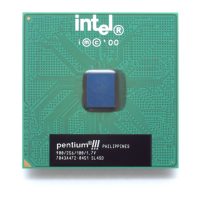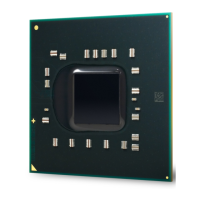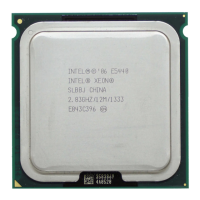Intel® Pentium® 4 Processor in the 478-Pin Package Processor Power Distribution Guidelines
R
Intel
®
Pentium
®
4 Processor / Intel
®
850 Chipset Family Platform Design Guide 225
11.4 Filter Specifications For VCCA, VCCIOPLL, and
VSSA
VCCA
and VCCIOPLL
are power sources required by the PLL clock generators on the processor
silicon. Since these PLLs are analog in nature they require quiet power supplies for minimum
jitter. Jitter is detrimental to the system: it degrades external I/O timings as well as internal core
timings (i.e., maximum frequency). To prevent this degradation these supplies must be low pass
filtered from VCC_CPU
.
The general desired filter topology is shown in Figure 168. Not shown in
the core is parasitic routing. Excluded from the external circuitry are parasitics associated with
each component.
Figure 168. Typical VCCIOPLL, VCCA and VSSA Power Distribution
VCC_CPU
VCCA
VSSA
VCCIOPLL
Processor
Core
PLLs
Mother board
pkg
c2
1 uF
33 uF
33 uF
4.7 uH
4.7 uH
C
A
C
IO
VCCIOPLL-VCCA-VSSA_PWR_Dist
The function of the filter is two-fold. It protects the PLL from external noise through low-pass
attenuation. It also protects the PLL from internal noise through high-pass filtering. In general, the
low-pass description forms an adequate description for the filter. For simplicity this document will
address the recommendation for the VCCA filter design. The same characteristics and design
approach is applicable for the VCCIOPLL filter design.
Note: The 1 µF package capacitor in Figure 168 does not exist on the Pentium 4 processor in the 478-pin
package. It is present for the Pentium 4 processor with 512-KB L2 cache on .13 micron process
only.
The AC low-pass recommendation, with input at VCC_CPU and output measured across the
capacitor (C
A
or C
IO
in Figure 168), is as follows:
• < 0.2 dB gain in pass band
• < 0.5 dB attenuation in pass band < 1 Hz (see DC drop in next set of requirements)
• 34 dB attenuation from 1 MHz to 66 MHz
• 28 dB attenuation from 66 MHz to core frequency
• The filter recommendation (AC) is graphically shown in Figure 169.

